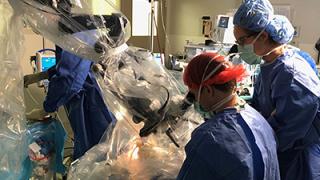
Oct 06, 2020 5:00 PM
Author: Doug Dollemore
The ears, nose, and throat are the fulcrums of three important senses: hearing, smell, and taste. When something goes wrong with these passageways, many patients are referred to doctors called otolaryngologists who specialize in ear, nose, and throat (ENT) surgery.
These surgeries include removing tonsils, widening sinus passages, and embedding cochlear implants in the ears to improve hearing. They require lots of drilling, cutting, and vaporizing bone and tissue. As a result, small fragments or particles of these bones and tissue float into the air, potentially exposing surgeons and nurses in operating rooms to harmful substances, including SARS-CoV2, the virus that causes COVID-19.
In a new animal study, University of Utah Health researchers recently determined that at least two common techniques used in otolaryngology surgeries can generate airborne particles containing evidence of viral DNA that are small enough to penetrate surgical masks. The researchers conclude that although the risk of viral transmission appears to be low, additional safeguards to protect health care workers from particle exposure in operating rooms should be implemented.
"This study for the first time characterizes the relative risk that certain surgical procedures can cause to health care providers," says Albert H. Park, MD, chief of pediatric otolaryngology and senior author of the study. "The impact to surgeons and those working in the operating room is clear. This work also provides the basis to study other potential aerosolizing procedures that are conducted in clinics and in hospitals. That has impact for all providers and patients seen in that environment."
The study appears in Otolaryngology—Head and Neck Surgery.
The researchers began investigating the possibility of viral transmission during otolaryngology surgeries after several reports indicated that SARS-CoV-2 virus particles are found in high concentrations in the mouth, nose, and throat of infected individuals. In addition, anecdotal reports from China, Italy, and Iran suggested that ENT specialists are among the physicians at highest risk of contracting the virus. Park and his colleagues suspected that this vulnerability was due in part to the nature of their work, which regularly exposes them to aerosol particles in the oral and nasal cavities.
To test this theory, the researchers conducted some common surgical procedures on healthy young mice and others infected with a mouse-specific cytomegalovirus. This virus can't be transmitted to humans but served as a model to determine if any aerosol particles produced during surgery contained viral material. They also wanted to find out if any of these procedures produced more aerosol particles than the others, and if these particles were small enough to penetrate surgical masks.
During these procedures, the scientists used four surgical techniques on the animals:
- Surgical Drill: Commonly used to cut the skull and other bony structures, For ENT, drilling is typically used to open the mastoid air cells that protect the delicate structures of the ear.
- Microdebrider: A Pac-Man-like device that nibbles away soft tissue, then sucks it up. It is often used for removal of small growths that develop on the vocal cords or nasal cavity.
- Coblation: A technique that creates a low-temperature plasma field used to precisely cut and remove soft tissue. For ENT purposes, it is usually used for tonsil and/or adenoid removal.
- Electrocautery: A small probe with an electric current running through it to vaporize tissue at high temperatures. It also can burn or seal blood vessels as well as reduce or stop bleeding during surgery.
The researchers found that three of 12 particle samples collected after coblation and three of 16 samples gathered after drilling contained detectable viral DNA. They did not find evidence that any of the viral DNA was infectious. Electrocautery, which generates high temperatures likely neutralized the virus, while microdebriding most likely produces far too few particles to be detected, Park says.
Although these findings are reassuring, Park cautions that viral transmission by aerosol particles is possible, and the majority of the particles generated are small enough to pass through surgical masks. In addition, electrocautery and coblation produced the most airborne particles and in concentrations that may be worse than exposure to second-hand cigarette smoke.
Based on these findings, the researchers recommend that otolaryngologists take extra precautions during surgery, including using modified drapes to reduce aerosol exposure, betadine irrigations during drilling to neutralize viruses, and smoke evaluators to reduce the risk of exposure to surgical smoke.
Study limitations include the short duration for the procedures tested (approximately seven minutes) and the small size of the mice. Many of these procedures typically take much longer than seven minutes, Park says. As a result, infectious viruses might be detected from longer procedures performed in human patients.

